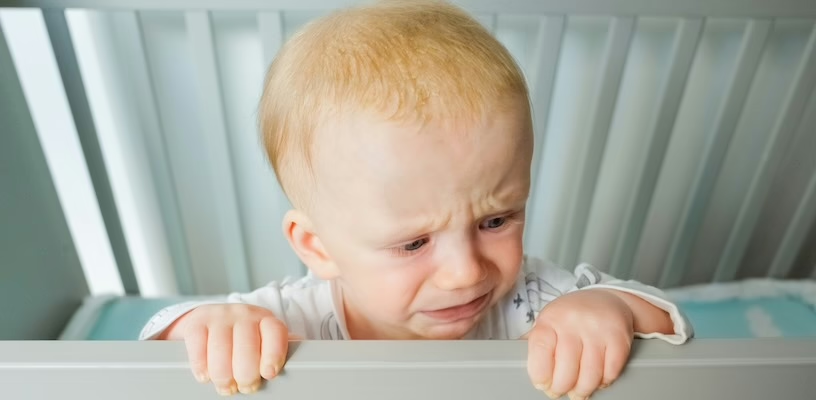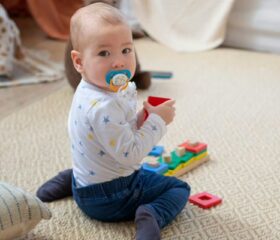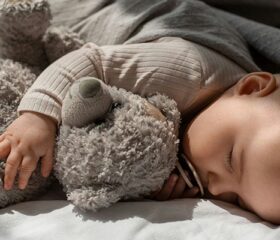Separation Anxiety in Babies: Tips for Night and Day
If you’re the parent of a baby or toddler who cries the moment you leave the room at bedtime, chances are you’re seeing nighttime separation anxiety up close and personal.

- What is separation anxiety?
- When does separation anxiety start?
- What does separation anxiety at night look like?
- What causes separation anxiety?
- How to deal with separation anxiety at night
- Tips to ease your child’s separation anxiety during the day
- How to look after yourself when dealing with separation anxiety
- Final thoughts
As if nighttime sleep wasn’t difficult enough for an already sleep-deprived parent, separation anxiety can add an extra challenge when putting your baby down for bed.
Let’s take a look at what separation anxiety really is, when it tends to show up, and what to do when your baby goes through it both during the day and at night.
What is separation anxiety?
Separation anxiety happens when your baby or toddler becomes distressed by being apart from a primary caregiver (usually his mom or dad). 1 It’s rooted in the bond you’ve built with your child.
Separation anxiety peaks when your baby starts to realize that you keep him safe, but doesn’t have the confidence to cope when you’re not around.
How object permanence affects separation anxiety
As your baby develops object permanence, which usually happens between 6 months and 9 months of age, he’ll begin to understand that people and things still exist even when they’re out of sight. 2
The tricky part is that he doesn’t yet grasp that you’ll always come back. This new awareness and his deep attachment to you can stir up strong feelings when you leave the room.
Is separation anxiety a disorder?
In babies and toddlers, separation anxiety isn’t a disorder, just a normal part of their development. Take it as a sign that your child is beginning to understand how relationships work.
However, separation anxiety disorder is something different. It typically isn’t diagnosed until a child is elementary school-aged and involves excessive worry that disrupts daily life. 3
If you’re concerned about separation anxiety in an older child (or a younger one with more extreme symptoms), check in with your pediatrician.
When does separation anxiety start?
While every child is different, at around 5 months to 7 months of age, most babies start showing signs of “stranger anxiety,” meaning they’ll notice the difference between familiar faces and unfamiliar ones. 4 Even Grandma might get the side-eye if she hasn’t been around much lately.
Although stranger anxiety is distinct, it can be the first sign that separation anxiety is on the horizon.
How long does separation anxiety last?
Separation anxiety tends to peak in 8 month-old to 12-month-old babies. 2 You might notice tears when you leave the room or clinginess during daycare drop-off.
Though toddlers tend to be more independent than babies, that doesn’t mean they’re ready to say goodbye without a fuss, and you might see lingering anxiety between 12 and 24 months. Even if he knows you’re coming back, that knowledge won’t always bring comfort in the moment. 5
In most kids, separation anxiety starts to ease by age 3. 2 As language, memory, and coping skills improve, so does your child’s ability to manage short separations.
What does separation anxiety at night look like?
Separation anxiety can show up in different ways, but one of the times you’re most likely to see it is when you put your baby down for sleep at night.
This is especially true for kids going through sleep regression, a phase where a baby that previously slept well suddenly has trouble sleeping or resists naps and bedtime altogether.
Your baby may cry relentlessly when you leave the room after saying goodnight, wake up frequently at night, or resist bedtime altogether. 6
During the day, your baby might also: 1
- Be clingy, especially in new or unpredictable situations
- Avoid certain caregivers, especially if they’re less familiar
- Have a lack of interest in exploring the environment when you’re not nearby
- Throw tantrums (especially if he’s a toddler)
It’s important to remember that these behaviors, including tantrums and fussing, aren’t misbehavior, but an expression of real distress. If your baby won’t sleep, respond with empathy rather than punishment to build trust between you and him. 7
What causes separation anxiety?
To reiterate, separation anxiety is a healthy and normal (albeit exhausting) part of your baby’s development. That said, a few factors can influence how and when it shows up.
Some children are just naturally more sensitive and prone to getting anxious. In all kids, though, big life changes, like moving house, welcoming a new sibling, or starting daycare, can heighten anxiety and clinginess. 8
The COVID-19 pandemic may still be contributing to separation anxiety in younger children
For many older toddlers, the COVID-19 pandemic limited early experiences with other caregivers. 9 If your child has had fewer chances to practice separations, he may need extra support, even though lockdowns and other restrictions have eased.
What can make separation anxiety worse?
Although separation anxiety is usually just a normal part of a child’s development, it can get worse due to: 10
- Illnesses and teething: If your child is sick with a cold or any other mild illness, he’s more likely to seek you out for comfort. If he can’t find you, he may fuss more than normal. The same goes for when your baby starts teething.
- Disruptions to your child’s routine: Any big changes to your child’s routine, whether that means starting school, moving house, or travelling to a new place, can make him more likely to act up when you leave him, even briefly.
- Reflux: Some studies have found that children who have gastroesophageal reflux (GER) are more likely to experience separation anxiety more intensely. 11
How to deal with separation anxiety at night
One way you can ease your baby’s separation anxiety at night is with a consistent bedtime routine. Try reading him a book, giving him a warm bath, or even just cuddling together, and you’ll let your baby know that it’s time to wind down. 6
You should also: 6
- Put your baby down when he’s drowsy but still awake: This helps him learn to fall asleep independently, which is a valuable skill during these phases of separation anxiety.
- Reassure him without overdoing it: If your baby cries at night, offer him brief comfort (like patting his back or speaking gently) without picking him up unless he really needs it.
- Keep nighttime visits low-key: Keep the lights low and interactions minimal so your baby doesn’t associate waking up with playtime or attention.
Regardless of the time of day, it’s always better to say goodbye to your baby rather than to just disappear without saying anything. The latter may only increase his anxiety over time. 12 Always say goodbye, even if it brings on tears.
What to know about sleep training babies with separation anxiety
Sleep training means teaching your baby to self-soothe (fall asleep by himself without you interfering).
Many parents claim it can help their kids sleep by themselves within a few days, and experts say it’s safe to try on babies aged 6 months old and above. 13
But while it can be a useful tool for combating separation anxiety at night, sleep training is controversial.
Many of the popular sleep training methods, such as the infamous cry-it-out (CIO) method, involve leaving your child to cry by herself without intervening. It can be traumatizing to hear your child wail night after night, and if you’d prefer not to put her or yourself through that, you don’t have to sleep train your child.
Tips to ease your child’s separation anxiety during the day
Separation anxiety won’t just strike at night; even going to the other room while your baby is awake could elicit a waterfall of tears.
One way to combat separation anxiety is by starting with brief departures. Step into another room for a few minutes or run a very quick errand, then come back. You can gradually work your way up from there.
You can also ease your baby’s separation anxiety by: 2
- Creating a goodbye ritual: Much like with a bedtime routine, a goodbye ritual can give your baby some much-needed predictability. Whether it be a hug, a kiss, or simply saying “I’ll see you after snacktime,” he’ll get more used to you leaving for short periods of time.
- Timing your goodbyes: However you choose to bid adieu to your child, try to say goodbye when he’s well-rested and fed. A tired, hungry baby is more likely to melt down.
- Introducing new caregivers gradually: Stay with your child as he gets to know new babysitters, grandparents, or daycare providers. Forcing a child into someone’s arms can backfire. Instead, give your child time to warm up naturally and encourage this caregiver to take on gentle roles like feeding, reading, or dressing.
- Trying a comfort object: Many parents find that giving their child a familiar object can ease their separation anxiety. If your child is over 6 months old, you could offer him his favorite soft toy or blanket so he feels reassured when you’re gone (but not if he’s any younger—before that, it’s safest to put him to sleep without anything else in the crib).
While it’s frustrating to deal with separation anxiety, try to stay calm. Babies and toddlers pick up on your emotions. If you’re anxious, he’ll sense it. Take a deep breath, smile, and relax. The more confident you are, the easier it’ll be on your baby.
How to look after yourself when dealing with separation anxiety
Separation anxiety can take as much of an emotional toll on you as it can on your child, and it’s understandable if you feel heartbroken walking away from him while he’s crying his eyes out at bedtime.
Still, your self-care is just as important as your baby’s, so don’t be afraid to take short breaks from him when you can. Not only will he get more accustomed to moments without you, but you’ll get some much-needed rest yourself.
If things get too much for you to handle, know that you’re not alone. Reach out to your family, friends, or doctor to get support if you need it.
Final thoughts
Separation anxiety can be overwhelming for even the most headstrong parents. While it’s a totally normal phase for your baby, dealing with it at night when you’d much rather get some shut-eye yourself is enough to test your patience.
But take heart in knowing that it won’t last forever. Soon enough, with the right strategies and plenty of love, you’ll both be saying goodnight without either of you crying your eyes out!
Article Sources
- MedlinePlus. "Separation anxiety in children" Retrieved October 23, 2025.
- HealthyChildren.org. "How to Ease Your Child’s Separation Anxiety" Retrieved October 23, 2025.
- Children's Hospital of Philadelphia. "Separation Anxiety Disorder" Retrieved October 23, 2025.
- Developmental Science. "The Development of Stranger Fear in Infancy and Toddlerhood: Normative Development, Individual Differences, Antecedents, and Outcomes" Retrieved October 23, 2025.
- Psychiatric Clinics of North America. "Anxiety and Anxiety Disorders in Children and Adolescents: Developmental Issues and Implications for DSM-V" Retrieved October 23, 2025.
- MedlinePlus. "Bedtime habits for infants and children" Retrieved October 23, 2025.
- National Academies Press. "Parenting Matters: Supporting Parents of Children Ages 0-8" Retrieved October 23, 2025.
- Nemours KidsHealth. "Separation Anxiety" Retrieved October 23, 2025.
- Journal of Family Issues. "Caregivers’ Experiences During the COVID-19 Pandemic and Their Children’s Behavior" Retrieved October 23, 2025.
- Mayo Clinic. "Separation anxiety disorder" Retrieved October 23, 2025.
- American Psychological Association. "When an infant has a feeding problem." Retrieved October 23, 2025.
- HeadStart.gov. "Daily Separations and Reunions (retrieved from archive.org)" Retrieved October 23, 2025.
- Sleep Doctor. "Sleep Training for Babies" Retrieved October 23, 2025.







